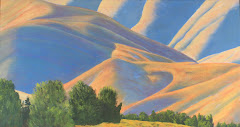I was raised on a farm in Illinois and I loved the barn. Actually, we had several barns for different uses - one for the dairy cattle, one for hay, one for machinery, etc. I spent a lot of time in them, even though I had hay fever as a boy and being in the barn meant spasms of sneezing and wheezing. I'd find litters of feral kittens, I'd jump from what seemed great heights onto relatively soft mounds of loose hay, and I'd play with friends among the several levels of stacks of grain being used up.
As I travel about Idaho, I often see barns or other out buildings simply abandoned after their effective uses were over. I'm certain there are stories for each structure, either about their uses, or about the dreams associated with the building's construction, or stories of boys playing within them, perhaps getting into trouble or hurting themselves or at the least creating memories still enfolded in the creases of their minds.
For me, and others who just pass them by, they take on a kind of charged imagery. They reflect our own gradual passing into a used up condition and they stir our fear of abandonment. They are just left out there, to decay in public and they aren't even taken apart for firewood.
I'm glad they aren't. There is a strange beauty to them for me. I've started a series of paintings of some of the ones I've come across in the countryside and I'm calling the series "Crashing Barns". Instead of looking passive, they look more as if they have been assaulted - dropped from the sky, hit by a meteor, tripped over a stump, exploded, or imploded. Often they fall apart as if time itself has repeatedly flown by and ripped off another board.
I will have four of these paintings at my gallery in Boise for January in the new year. Come down to 403 S 8th St to see them if you are in Boise.

web.jpg)
.jpg)





